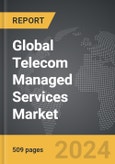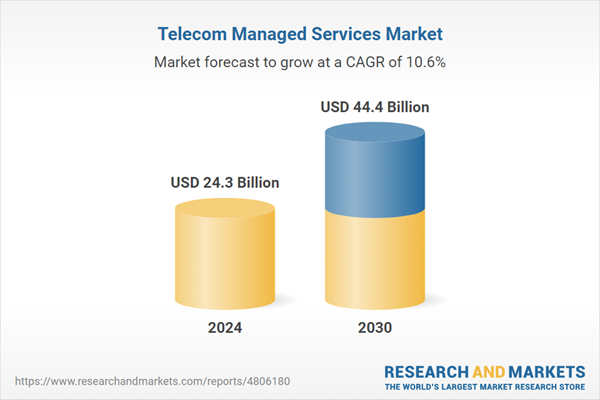The global market for Telecom Managed Services was valued at US$24.3 Billion in 2024 and is projected to reach US$44.4 Billion by 2030, growing at a CAGR of 10.6% from 2024 to 2030. This comprehensive report provides an in-depth analysis of market trends, drivers, and forecasts, helping you make informed business decisions. The report includes the most recent global tariff developments and how they impact the Telecom Managed Services market.
Segments: Service Type (Managed Data Center, Managed Data & Information, Managed Communication, Managed Network, Managed Mobility, Managed Security); Organization Size (Large Enterprises, SMEs).
Geographic Regions/Countries: World; USA; Canada; Japan; China; Europe; France; Germany; Italy; UK; Spain; Russia; Rest of Europe; Asia-Pacific; Australia; India; South Korea; Rest of Asia-Pacific; Latin America; Argentina; Brazil; Mexico; Rest of Latin America; Middle East; Iran; Israel; Saudi Arabia; UAE; Rest of Middle East; Africa.
The analysts continuously track trade developments worldwide, drawing insights from leading global economists and over 200 industry and policy institutions, including think tanks, trade organizations, and national economic advisory bodies. This intelligence is integrated into forecasting models to provide timely, data-driven analysis of emerging risks and opportunities.
Global Telecom Managed Services Market - Key Trends & Drivers Summarized
What Are Telecom Managed Services and Why Are They Crucial for Modern Businesses?
Telecom managed services encompass a wide range of operational functions outsourced by companies to specialized service providers to manage and optimize their telecommunications infrastructure. This can include the management of voice services, data services, network operations, maintenance, and other support systems integral to telecommunications. The primary advantage of these services is that they allow businesses to focus on their core competencies while leaving the complex, time-consuming task of managing telecom operations to experts. This not only reduces operational costs but also enhances efficiency and scalability. With the telecommunications sector becoming increasingly complex due to advancements in technology such as 5G, IoT, and cloud computing, managed services play a pivotal role in ensuring businesses can adapt and thrive without compromising on quality or performance.How Is Technology Transforming Telecom Managed Services?
Technological advancements are significantly reshaping the landscape of telecom managed services. The integration of artificial intelligence (AI) and machine learning (ML) has revolutionized service management by enabling predictive maintenance, which anticipates failures and mitigates them before they affect operations. Additionally, automation technologies are used to streamline processes, reducing the need for human intervention and minimizing errors. This shift towards automation not only improves operational efficiency but also helps in optimizing resource allocation and reducing downtime. Furthermore, the adoption of cloud technologies enhances the flexibility and scalability of telecom services, allowing providers to offer more robust and adaptable solutions to businesses. These technological innovations are critical as they provide telecom managed services with the tools to offer more reliable, efficient, and cost-effective solutions to their clients.What Current Trends Are Influencing the Telecom Managed Services Market?
Several current trends are driving the evolution of the telecom managed services market. The increasing complexity of network infrastructure, including the proliferation of devices connected through the Internet of Things (IoT), demands sophisticated management tools that can handle large-scale, dynamic networks. Another trend is the growing need for cybersecurity in telecommunications, as the rise in cyber threats necessitates robust security measures to protect sensitive data and maintain network integrity. Additionally, the shift towards virtualized network services, such as Software-Defined Wide Area Networks (SD-WAN) and Network Functions Virtualization (NFV), requires specialized knowledge that managed service providers are uniquely positioned to offer. These providers are also expanding their services to include consulting and business intelligence, leveraging data analytics to offer strategic insights that help businesses improve performance and competitive advantage.What Drives the Growth in the Telecom Managed Services Market?
The growth in the telecom managed services market is driven by several factors that highlight the increasing dependence of businesses on sophisticated telecommunications infrastructure. Technological advancements, particularly in AI, automation, and cloud computing, are critical as they enhance the capabilities of managed services, making them more efficient and adaptable to the changing needs of businesses. The expansion of IoT and the consequent complexity of network management also contribute significantly to the demand for specialized telecom managed services. Moreover, as businesses increasingly focus on cost reduction and operational efficiency, outsourcing telecom management becomes a viable strategy to achieve these objectives without compromising service quality or network security. Consumer behavior trends, such as the expectation for uninterrupted service and instant connectivity, push telecom providers to maintain highly reliable and efficient networks, further fueling the growth of managed services. Lastly, regulatory changes and the need for compliance in telecommunications encourage businesses to rely on managed service providers who are well-versed in the legal aspects of telecom operations. These factors collectively drive the sustained growth and evolution of the telecom managed services sector, ensuring its relevance and indispensability in the digital age.Report Scope
The report analyzes the Telecom Managed Services market, presented in terms of units. The analysis covers the key segments and geographic regions outlined below.Segments: Service Type (Managed Data Center, Managed Data & Information, Managed Communication, Managed Network, Managed Mobility, Managed Security); Organization Size (Large Enterprises, SMEs).
Geographic Regions/Countries: World; USA; Canada; Japan; China; Europe; France; Germany; Italy; UK; Spain; Russia; Rest of Europe; Asia-Pacific; Australia; India; South Korea; Rest of Asia-Pacific; Latin America; Argentina; Brazil; Mexico; Rest of Latin America; Middle East; Iran; Israel; Saudi Arabia; UAE; Rest of Middle East; Africa.
Key Insights:
- Market Growth: Understand the significant growth trajectory of the Large Enterprises segment, which is expected to reach US$18.7 Billion by 2030 with a CAGR of a 8.1%. The SMEs segment is also set to grow at 12.6% CAGR over the analysis period.
- Regional Analysis: Gain insights into the U.S. market, valued at $12.3 Billion in 2024, and China, forecasted to grow at an impressive 14.5% CAGR to reach $3.7 Billion by 2030. Discover growth trends in other key regions, including Japan, Canada, Germany, and the Asia-Pacific.
Why You Should Buy This Report:
- Detailed Market Analysis: Access a thorough analysis of the Global Telecom Managed Services Market, covering all major geographic regions and market segments.
- Competitive Insights: Get an overview of the competitive landscape, including the market presence of major players across different geographies.
- Future Trends and Drivers: Understand the key trends and drivers shaping the future of the Global Telecom Managed Services Market.
- Actionable Insights: Benefit from actionable insights that can help you identify new revenue opportunities and make strategic business decisions.
Key Questions Answered:
- How is the Global Telecom Managed Services Market expected to evolve by 2030?
- What are the main drivers and restraints affecting the market?
- Which market segments will grow the most over the forecast period?
- How will market shares for different regions and segments change by 2030?
- Who are the leading players in the market, and what are their prospects?
Report Features:
- Comprehensive Market Data: Independent analysis of annual sales and market forecasts in US$ Million from 2024 to 2030.
- In-Depth Regional Analysis: Detailed insights into key markets, including the U.S., China, Japan, Canada, Europe, Asia-Pacific, Latin America, Middle East, and Africa.
- Company Profiles: Coverage of players such as IBM Corporation, Huawei Technologies Co., Ltd., AT&T, Inc., Nokia Corporation, NTT Communications Corporation and more.
- Complimentary Updates: Receive free report updates for one year to keep you informed of the latest market developments.
Some of the 46 companies featured in this Telecom Managed Services market report include:
- IBM Corporation
- Huawei Technologies Co., Ltd.
- AT&T, Inc.
- Nokia Corporation
- NTT Communications Corporation
- AMDOCS
- Tata Communications Ltd.
- NTT DATA Corporation
- Nippon Telegraph and Telephone Corporation (NTT)
- Cerillion Technologies Ltd.
- GTT Communications, Inc.
- Manx Telecom Ltd.
- Subex Limited
- Aptum Technologies
- GTL Limited
Tariff Impact Analysis: Key Insights for 2025
Global tariff negotiations across 180+ countries are reshaping supply chains, costs, and competitiveness. This report reflects the latest developments as of April 2025 and incorporates forward-looking insights into the market outlook.The analysts continuously track trade developments worldwide, drawing insights from leading global economists and over 200 industry and policy institutions, including think tanks, trade organizations, and national economic advisory bodies. This intelligence is integrated into forecasting models to provide timely, data-driven analysis of emerging risks and opportunities.
What’s Included in This Edition:
- Tariff-adjusted market forecasts by region and segment
- Analysis of cost and supply chain implications by sourcing and trade exposure
- Strategic insights into geographic shifts
Buyers receive a free July 2025 update with:
- Finalized tariff impacts and new trade agreement effects
- Updated projections reflecting global sourcing and cost shifts
- Expanded country-specific coverage across the industry
Table of Contents
I. METHODOLOGYII. EXECUTIVE SUMMARY2. FOCUS ON SELECT PLAYERSIII. MARKET ANALYSISCANADAITALYSPAINRUSSIAREST OF EUROPESOUTH KOREAREST OF ASIA-PACIFICBRAZILMEXICOREST OF LATIN AMERICAIV. COMPETITION
1. MARKET OVERVIEW
AMDOCS (USA)
3. MARKET TRENDS & DRIVERS
4. GLOBAL MARKET PERSPECTIVE
UNITED STATES
JAPAN
CHINA
EUROPE
FRANCE
GERMANY
UNITED KINGDOM
ASIA-PACIFIC
AUSTRALIA
INDIA
LATIN AMERICA
MIDDLE EAST
AFRICA
Companies Mentioned (Partial List)
A selection of companies mentioned in this report includes, but is not limited to:
- IBM Corporation
- Huawei Technologies Co., Ltd.
- AT&T, Inc.
- Nokia Corporation
- NTT Communications Corporation
- AMDOCS
- Tata Communications Ltd.
- NTT DATA Corporation
- Nippon Telegraph and Telephone Corporation (NTT)
- Cerillion Technologies Ltd.
- GTT Communications, Inc.
- Manx Telecom Ltd.
- Subex Limited
- Aptum Technologies
- GTL Limited
Table Information
| Report Attribute | Details |
|---|---|
| No. of Pages | 509 |
| Published | April 2025 |
| Forecast Period | 2024 - 2030 |
| Estimated Market Value ( USD | $ 24.3 Billion |
| Forecasted Market Value ( USD | $ 44.4 Billion |
| Compound Annual Growth Rate | 10.6% |
| Regions Covered | Global |









